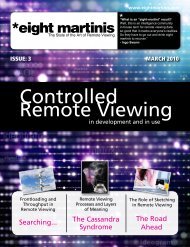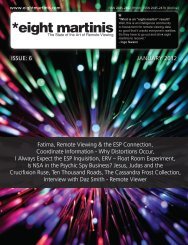Download FREE now! - Eight martinis is a magazine
Download FREE now! - Eight martinis is a magazine
Download FREE now! - Eight martinis is a magazine
Create successful ePaper yourself
Turn your PDF publications into a flip-book with our unique Google optimized e-Paper software.
Ingo Swann - art<strong>is</strong>t, author and father of modernremote viewing.Within the expanding subject of Remote Viewing, made popularby the radio broadcasts by no1 ranked radio station Coastto Coast AM, Remote Viewing has <strong>now</strong> reached millions ofAmericans and many other l<strong>is</strong>teners from across the globe.Coast to Coast regularly features the leading lights of RemoteViewing in its broadcasts as its l<strong>is</strong>teners lap up the tales ofpsychic spying foray’s against the Russians, encounters withUFOs and aliens and speculation over the search for terror<strong>is</strong>tsincluding Osama Bin Laden. But we are getting ahead ofourselves here - the real story of how modern Remote Viewingbegan has its roots in the 1970s. A well k<strong>now</strong>n time in man’spast where ideas and social boundaries were changing. Therewas a sense of freedom in the air, a time where colour seemedto explode in to our lives from a black and white ex<strong>is</strong>tence ofthe 1960s. From th<strong>is</strong> new dawn of ideas and expression camea man who would change all of our lives - Ingo Swann.Ingo Swann was born in September 14th 1933, Telluride,Colorado, an <strong>is</strong>olated town nestled high in the safety of theRocky Mountains. Ingo says:”All things considered, my childhood was wonderful -as has been, all things again considered, my whole life.And I will admit that in th<strong>is</strong> I feel I have been blessed.I was precocious. I read my first dictionary when I wasthree or thereabouts. When Mom was talked into buyingthirty volumes of the ENCYCLOPEDIA BRITANNICAfrom a travelling salesman, I had them all read, entry toentry, by the time I got into kindergarten.So I was a problem in kindergarten. I used big wordswhen my peers were struggling with the alphabet andpictures of elephants, sheep and f<strong>is</strong>hes. I could alreadyd<strong>is</strong>tingu<strong>is</strong>h between elephants of India and those ofAfrica, while the teacher didn’t k<strong>now</strong> there was a difference.I had what was called an “overactive mind” as a child.Th<strong>is</strong> worried my family and others, especially whentaken beyond the reading dictionaries, encyclopaediasand whatnot.I also liked to take things apart and put them back togetheragain. For example, not just Tinker Toys, but thekitchen stove, the plumbing, the telephone and clocks- everything including, to everyone’s horror, the piano.I got it all back together, but my Dad had to pay $40 toget it retuned.But I was consumed by d<strong>is</strong>covering how things worked,and was serious and determined in th<strong>is</strong> regard. I madecharts and graphs and drawings. Most people don’tcare how things work. They just use them.And herewith was the beginning of those illustrationsand graphs and box-and-flow charts which many yearslater were dragged from Stanford Research Instituteinto the Pentagon and DIA headquarters and presentedto their oversight committees and consulting scient<strong>is</strong>ts.Diagrams of how, theoretically at least, the so-called“psychic mind” functions.” 1Ingo graduated in 1955 with a double major in biology andart, subjects that remain at the forefront of who Ingo <strong>is</strong> anda invaluable tool to breaking down the psychic process thatremain with Ingo to th<strong>is</strong> very day.As was the norm in 1955, Ingo completed two years service inthe U.S. army spending most of th<strong>is</strong> time in Korea, where hemade the dec<strong>is</strong>ion to move to New York and become a painter.It was also the eventful year 1955 that both the Ingo’s worldsof creative experience and psychic functioning came togetherfrom a book he read during basic training at Fort Knox. Th<strong>is</strong>ground breaking classic book was ‘Doors of Perception’ by AldousHuxley (1954) as Ingo says in h<strong>is</strong> own words;“Th<strong>is</strong> book was the beginning of a watershed for me.For, you see, in spite of my voracious appetite for readingand book worming study, no one else had ever saidit, nor had it dawned on me that perceptions have“doors” -- and that those doors can be OPEN or SHUT.Th<strong>is</strong> led almost immediately to the understanding thatpeople probably have all kinds of perceptions. But thedoors to them can either be open or shut. Th<strong>is</strong> REVELA-TION, for that <strong>is</strong> what it was, that both the creative processesAND psi experiencings are, at base, almost certainlya matter of what doors of perception are open orshut in given individuals.I was stunned by th<strong>is</strong> concept, and still am. Thereafter,as a matter of serious research and amusement, I setabout observing all kinds of people with regard to seeingor sensing which of their doors of perception areopen or shut.Stat<strong>is</strong>tically speaking, of course, there are more shutsthan opens. Th<strong>is</strong> <strong>is</strong> something you can determine foryourself if you take interest in observing others withthe goal of watching which of their doors of perceptionsare open or shut.Therein lies a very great tale to be told, and some fullpart of the saga and soap opera of remote viewing resideswithin it.” 1In New York Ingo supported himself by working in the UnitedNations as a typ<strong>is</strong>t until 1968, when he decided to become afull time painter and writer. At first times were hard as it <strong>is</strong> forall who embark on a self employed way of working, and Ingomostly supported himself by writing a number of ‘sexual fic-*eight <strong>martin<strong>is</strong></strong> 5







